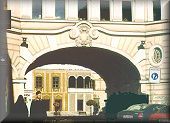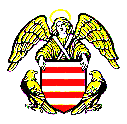Though the town territory had been settled well in the past, its rapid growth started with the beginning of intensive copper and gold mining. The first report of the town dates from 1255. The Hungarian King Belo IV honored the settlement by turning it into a town. The mining was at the time quite progressive and so the town grew in prosperity and became rich very quickly. Royal privileges attracted new miners - German settlers, who built a Romanesque one-nave Church of the Virgin Mary in the second half of the 13th century. In 1452 old Slavs built the Church of the Holy Cross next to the Romanesque church, under the town walls, nearby Matthias's House. Thus a castle complex with the townhall, barbican (today's tourist office) and fortress was formed.
Eloquent testimony of prosperity and the level of material and spiritual culture in the 15th and 16th century are demonstrated by many of important buildings. The most precious are in the historical core, i.e. on the square area and in the main streets.
Luxurious mine proprietor's gothic mansions belong to today's most important Slovak renaissance buildings. The heart of Banská Bystrica was proclaimed the historical town preservation area, and the castle area - national cultural preservation area.
Other architectural and artistic monuments are the Matthias's House built in the late Gothic style, the renaissance Town Hall and the Church of Assuption of Virgin Mary with the Chapel of St. Barbora. The altar from the beginning of the 16th century is the work of Pavol, the master of Levoča and it's southern side shows an interesting relief, the Olive Mountains.
The rich patricians built showy houses in Gothic and Renaissance style. Some of them, e.g. Thurzo's House or Benicky' House have high architectural and historical value.
In 1589 the town was completely surrounded by stone walls. The remnants of the town fortress and walls witnessed very hard fightings against the invading Turks (in 1526). Only remains of the huge stone walls have been preserved till today.
Banská Bystrica, thanks to its position, rich history and many medieval remains, became one of the most important and beautiful mining towns in Slovakia.
Another chapter of the history was writen during the World War II. The town served as a centre of anti-fascist resistence and a political and military centre of Slovak National Uprising. A symbol of this event is a architecturally interesting monumental buliding of the memorial of the Slovak National Uprising.
According to the last census the population of Banská Bystrica is about 90000.

